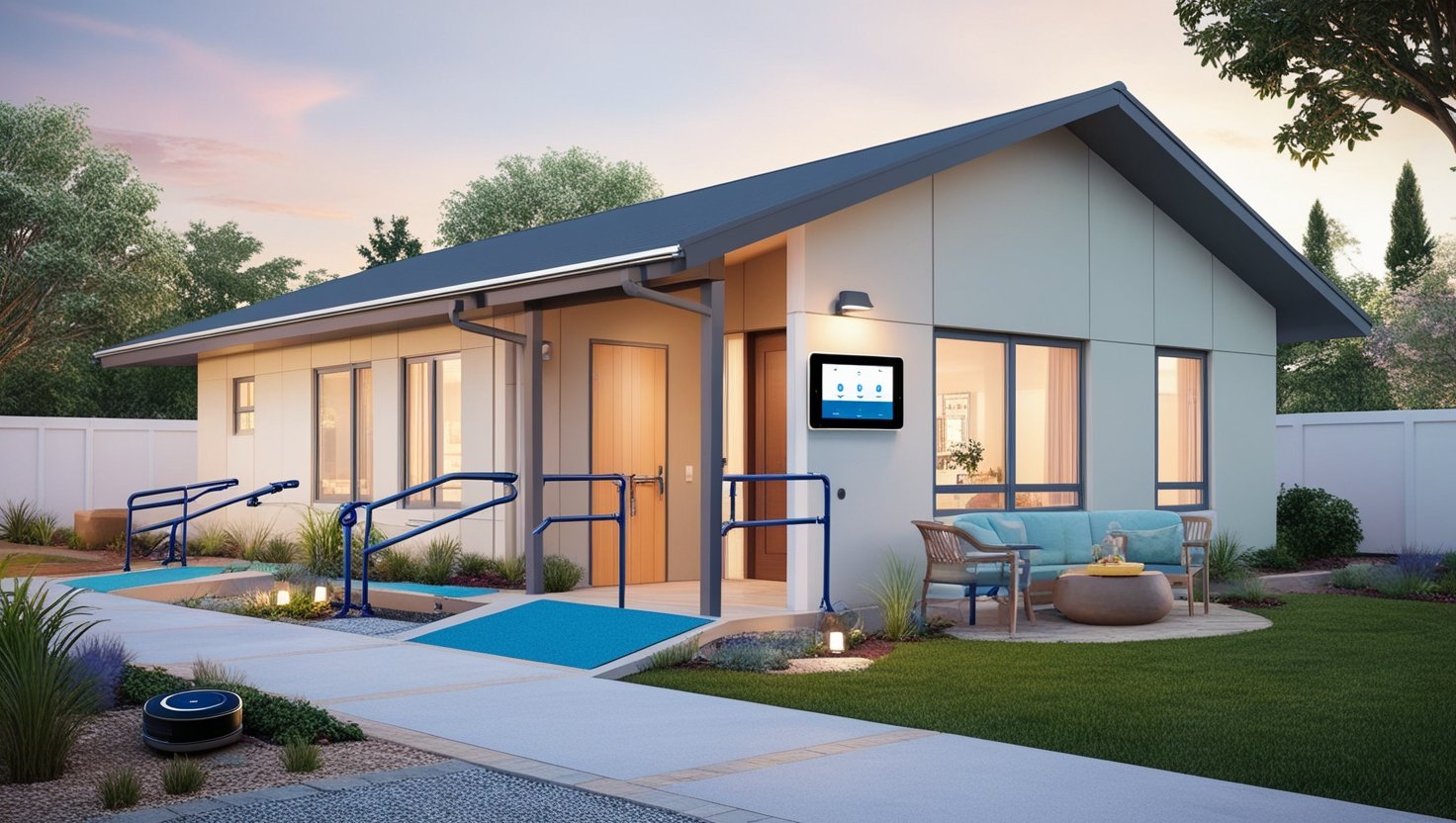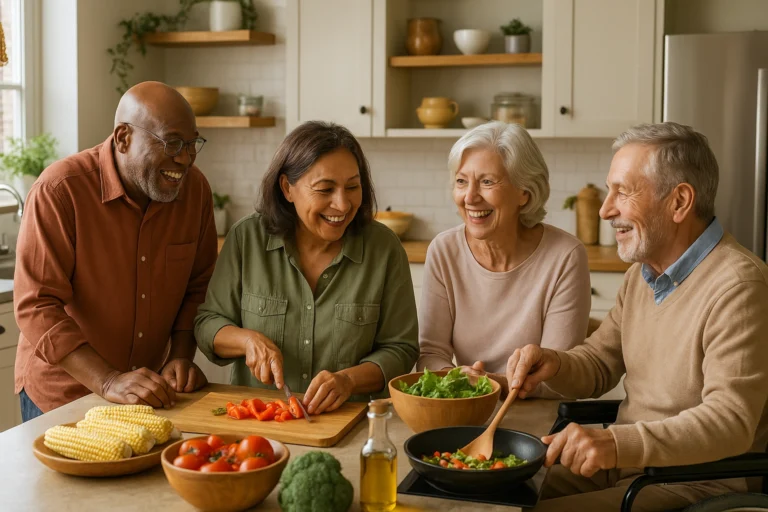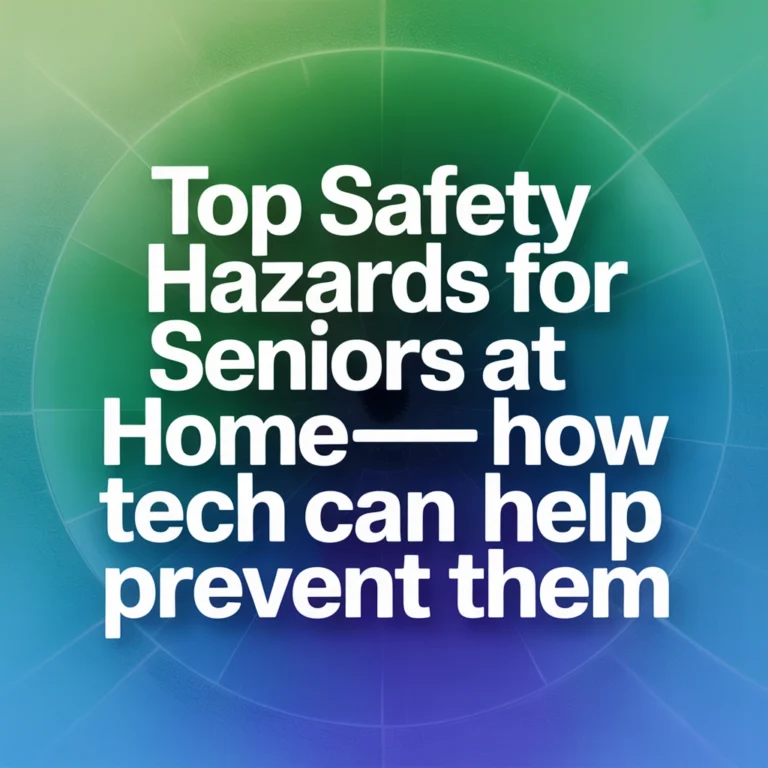As we age, ensuring our loved ones feel safe in their homes becomes essential. For seniors, simple daily tasks can pose safety risks. That’s why making thoughtful modifications can significantly impact their well-being. When we consider how to make your home safe for seniors, it’s not just about convenience—it’s about preserving independence and peace of mind.
In this article, we’ll explore seven senior-friendly home modifications that enhance safety. Each modification addresses common hazards many overlook. From non-slip flooring to improved lighting solutions, these changes can dramatically lower the risk of accidents at home. Let’s dive into practical strategies that will not only safeguard your loved ones but also create a nurturing living environment they deserve. Your journey toward a safer home for seniors starts right here! For more tips and resources, visit SeniorThrive—your go-to guide for enhancing senior safety and well-being.
Safety Essential for Seniors: #1 Non-Slip Flooring

One of the most effective ways to make your home safe for seniors is to invest in non-slip flooring. Falls are a leading cause of injuries among older adults, and many accidents happen right in their homes. Non-slip materials provide much-needed traction and can significantly reduce the risk of slips and falls, helping seniors maintain their independence with greater confidence. By choosing surfaces designed with safety in mind, you can create an environment that fosters mobility and peace of mind.
When it comes to non-slip flooring options, there are several to consider. Vinyl flooring is a popular choice because it’s not only slip-resistant but also offers a soft surface that feels pleasant underfoot. Ceramic tiles can also be treated for better grip without sacrificing style. You might even explore rubber flooring in areas like kitchens or laundry rooms since it has excellent slip-resistance and cushioning properties. Each option carries unique aesthetic qualities while enhancing safety—a win-win for both functionality and design!
Installation plays a crucial role in ensuring that your non-slip flooring performs at its best. Start by ensuring the subfloor is level; uneven surfaces can compromise safety features. For vinyl or rubber products, follow the manufacturer’s guidelines closely during installation to secure proper adhesion. In addition, using non-slip pads underneath area rugs not only helps keep them in place but also adds another layer of protection against slips in high-traffic areas.
By prioritizing non-slip flooring as part of senior home modifications, you’re taking an essential step toward preventing falls and increasing overall safety. With various stylish materials available, you don’t have to sacrifice aesthetics for safety. Small changes can lead to significant improvements in how seniors move around their homes confidently!
Safety Essential for Seniors: #2 Improved Lighting Solutions

Proper lighting plays a crucial role in enhancing safety for seniors at home. Many accidents happen due to inadequate visibility, especially during the night or in dimly lit spaces. Just imagine navigating through a dark room only to trip over an unseen object. By improving lighting for safety, you can significantly minimize such risks. Effective lighting not only helps prevent falls but also boosts confidence for seniors when moving around their homes.
When it comes to lighting options, consider using LED lights and motion-sensor fixtures. LEDs are energy-efficient and provide bright illumination while using less power. Motion-sensor lights can automatically turn on when someone enters a room, which is incredibly useful in hallways or bathrooms during nighttime visits. Adding these features creates a safer environment where seniors won’t have to fumble for light switches or worry about stumbling in poorly lit areas.
It’s also important to maximize natural light in aging spaces whenever possible. Larger windows can brighten up rooms and make them feel more inviting. Consider trimming any overgrown trees or bushes outside that may block sunlight from entering your home. Additionally, using lighter window treatments can help improve brightness during daylight hours without compromising privacy.
Incorporating various types of lighting—such as task lights near reading areas or under-cabinet lights in kitchens—can further enhance safety and functionality. Thoughtful planning of how you illuminate a space makes all the difference for seniors as they navigate their homes with ease and assurance.
Safety Essential for Seniors: #3 Tripping Hazard Removal

When it comes to how to make your home safe for seniors, removing tripping hazards is a top priority. Many common household items can pose serious risks. Think about loose rugs or electrical cords that stretch across walking paths. Even clutter like shoes, magazines, and pet toys can create obstacles that might lead to falls. By identifying these hazards, you take the first step toward a safer living environment.
Decluttering isn’t just about aesthetics; it’s essential for safety too! Start by examining each room and determining what items are absolutely necessary. Consider using storage bins or baskets to keep smaller items organized and out of the way. Rearranging furniture can also create more open space, allowing your loved one to move freely without worrying about bumping into things.
Remember, an organized space not only looks better but helps prevent accidents.
Maintaining clear pathways both indoors and outdoors cannot be overstated. Take time to regularly check walkways for obstructions like leaves or garden tools that can be easily overlooked during busy days. For outdoor areas, make sure pathways are even and well-lit at night. Installing motion-sensor lights along walkways increases visibility and adds another layer of safety when heading outside after dark.
By focusing on tripping hazard removal, you’re significantly boosting the safety of seniors in your life. Whether it’s taking small steps with decluttering or making larger changes in layout, every effort counts toward creating a safer and more comfortable home environment. Remember, prevention is key; a simple change can go a long way in ensuring their independence while minimizing risk.
Safety Essential for Seniors: #4 Handrails and Grab Bars

Installing handrails and grab bars is vital in preventing falls, especially for seniors. Start by assessing areas where they often need support. Common locations include staircases, near doorways, and along hallways. In bathrooms, placing grab bars around the tub or shower can make a significant difference. This simple addition transforms potentially dangerous spaces into safe zones for daily activities.
When it comes to styles and materials, there are plenty of options available. For indoor handrails, wooden designs can blend well with home decor while providing strength and stability. On the other hand, stainless steel grab bars offer durability and resistance to rust, making them ideal for bathrooms and kitchens. Choose finishes that complement your interiors but also ensure functionality isn’t compromised—consider textured grips for added security.
These installations play a crucial role in enhancing bathroom safety upgrades as well. They help older adults maintain balance while shifting positions or stepping in and out of tubs or showers. Not only do these modifications reduce the risk of accidental slips, but they also empower seniors to feel more confident moving around their homes independently.
Encouraging family members to assist in selecting appropriate styles can be beneficial too. Involving them allows for a discussion about what works best aesthetically while ensuring all needs are met practically—and it strengthens interpersonal bonds through shared experiences in creating a safer living environment.
Safety Essential for Seniors: #5 Accessible Bathroom Modifications

Making your bathroom more accessible is crucial for seniors. One of the best changes is installing a walk-in tub or a curbless shower. These options eliminate the need to step over high thresholds, significantly reducing the risk of slips and falls. For example, a walk-in tub features a door that allows easy entry and exit, making bath time less stressful. Curbless showers, on the other hand, provide level access and can often accommodate shower seats for added comfort and safety.
In addition to these larger modifications, small adjustments can also greatly enhance accessibility. Using anti-slip mats in both tubs and showers can prevent dangerous slips during bathing. Raised toilet seats are another effective solution; they make it easier for seniors to sit down and stand up with less strain on their knees and backs. These simple touches can dramatically improve safety levels while encouraging independence in daily routines.
Organization plays an essential role in creating a safer bathroom environment, too. Clear clutter from surfaces like countertops and ensure that frequently used items are well within reach. Consider installing shelves or cabinets at lower heights so everything is easy to grab without stretching or bending over. Keeping pathways clear also helps prevent accidents, allowing seniors to move around freely without tripping hazards.
By implementing these accessible bathroom modifications, you’re not just focusing on safety; you’re also empowering your loved ones to maintain their independence comfortably. Whether you’re researching how to make your home safe for seniors or exploring stair safety solutions, remember that a little thoughtfulness today leads to significant peace of mind tomorrow!
Safety Essential for Seniors: #6 Emergency Preparedness
Being prepared for emergencies is crucial for seniors. A well-thought-out emergency plan can make all the difference during stressful situations. One essential feature to consider is an alert system. Options like wearable medical alert devices can provide quick access to help at the push of a button. These systems often connect directly to emergency personnel or family members, ensuring immediate assistance when it’s needed most.
Creating a robust emergency plan is also important. This should include easy access points for help—whether that means knowing which neighbors are available or identifying nearby emergency services. Encourage seniors to keep important contact numbers visible and accessible at all times, perhaps on a magnetic board in the kitchen or by their bedside. It’s also helpful to establish a routine check-in with trusted family members, ensuring there’s always someone watching out for them.
Furthermore, thoughtful furniture arrangements can improve safety during emergencies too. For instance, keeping pathways clear allows quick movement if a senior needs to evacuate due to fire or other threats. Accessible furniture arrangements ensure everything they might need is easily reachable but still organized enough not to create additional hazards during unexpected events.
Ultimately, combining technology with practical planning helps foster a sense of security and independence. It reassures both seniors and their loved ones that appropriate measures are in place, allowing everyone peace of mind in daily activities and during emergencies alike.
Safety Essential for Seniors: #7 Smart Home Technology

Integrating smart home technology can greatly enhance safety for seniors. Devices like smart locks and security cameras help families monitor their loved ones while maintaining privacy. For instance, a smart lock allows seniors to enter their homes without fumbling for keys, providing an extra layer of security. Security cameras placed strategically around the home can give family members peace of mind, ensuring they can check in when needed.
Monitoring systems tailored specifically for seniors also offer numerous benefits. These systems can alert caregivers if unusual activity is detected, such as prolonged inactivity or a fall. Some devices even come with emergency buttons that allow seniors to call for assistance quickly and easily. This kind of immediate response capability is key in enhancing emergency preparedness for seniors living alone.
To make the most of these technologies, consider how to integrate them seamlessly into daily life. Start by selecting user-friendly devices designed with seniors in mind. For example, use voice-activated assistants that can help with reminders or control other smart appliances without needing complex commands. It’s important to educate seniors on how to use these tools comfortably, ensuring they feel confident rather than overwhelmed by technology.
Ultimately, leveraging smart home technology helps establish a safer environment while promoting independence for seniors. It supports families in providing care from afar and encourages proactive measures in emergency situations. By embracing these innovations, you contribute significantly to making your home safe for seniors while improving their overall quality of life.
Maintaining Independence
Making safety modifications in the home allows seniors to maintain their independence for longer. When a living environment is tailored to meet their needs, older adults can navigate their homes confidently and comfortably. Features like grab bars in bathrooms or non-slip flooring can significantly reduce the fear of falls, empowering seniors to live without constant supervision. As these modifications support greater autonomy, they enhance overall quality of life by fostering self-reliance.
There are various resources available that help families afford these essential upgrades. Many community organizations and local government programs offer funding assistance specifically for home safety modifications geared towards seniors. For example, programs might provide grants or low-interest loans to aid with installing ramps, widening doorways for wheelchair access, or even subsidizing smart home technology installations. Checking with local aging services can open doors to financial help that eases the burden on family budgets.
Family involvement is crucial throughout this modification process. Discussing needed changes together ensures that everyone’s perspectives are taken into account while selecting practical solutions. By encouraging loved ones to participate in planning and decisions, the process becomes more collaborative and less daunting for seniors. Plus, inviting family members to assist with rearranging furniture or clearing tripping hazards promotes safe outdoor spaces too—allowing seniors to enjoy fresh air without worry!
Ultimately, practical modifications not only enhance safety but also enrich the lives of elderly family members by allowing them greater freedom in their daily activities. These thoughtful changes encourage independence while building a supportive network among caregivers and families dedicated to preserving dignity and choice within senior lives.
Creating a Safe Haven for Seniors
Ensuring our homes are safe for seniors is crucial. Simple modifications can significantly reduce the risk of accidents and promote independence. From non-slip flooring to emergency alert systems, every change counts. These adjustments not only improve safety but also enhance comfort and peace of mind for elders and their families.
Now it’s time to take action. Consider how you can make your home safe for seniors today. Whether it’s installing grab bars or improving lighting, your efforts will create a supportive environment. Remember, a safer home means happier, healthier aging for your loved ones. Let’s work together to foster an atmosphere where seniors can thrive!
If you want to learn more or you want to suggest anything – contact us!



